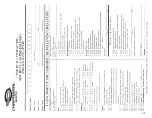
Safe Boating Courses
Your local U.S. Coast Guard Auxiliary and the U.S. Power
Squadrons offer comprehensive safe boating classes several times
a year. You may contact the Boat/U.S. Foundation at 1-800-336-
BOAT (2628), or in Virginia 1-800-245-BOAT (2628). For a course
schedule in your area you may also contact your local U.S. Coast
Guard Auxiliary or Power Squadron Flotilla for the time and place of
their next scheduled class.
U.S. Coast Guard Website:
www.uscg.mil
Power Squadron Website:
www.usps.org
Voluntary Inspections
State boating officials in many states or the U.S. Coast Guard
Auxiliaries offer courtesy inspections to check out your craft. They
will check your boat for compliance with safety standards and
required safety equipment. You may voluntarily consent to one of
these inspections and you are allowed time to make corrections
without prosecution. Check with the appropriate state agency or the
Coast Guard Auxiliary for details.
Rules of the Road
All responsible boaters comply with the “Rules of the Road,” the
marine traffic laws enforced by the U.S. Coast Guard. There are two
sets of rules: the United States Inland Navigational Rules and the
International Rules. The United States Inland Rules apply to all ves-
sels inside the demarcation lines separating inland and international
waters. The Coast Guard publishes the “Rules of the Road” in its pub-
lication “Navigational Rules, International-Inland.” You can get a copy
from your local U.S. Coast Guard Unit or the United States Coast
Guard Headquarters, 1300 E. Street NW, Washington, D.C. 20226.
Other helpful publications available from the U.S. Coast Guard
include “Aids to Navigation” (U.S. Coast Guard pamphlet #123),
which explains the significance of various lights and buoys; the
“Boating Safety Training Manual”; and “Federal Requirements For
Recreational Boats.” Check with your local Coast Guard station,
your Chaparral dealer, or a local marina about navigational aids
unique to your area.
U.S. Coast Guard Website:
www.uscg.mil
If you have a marine radio telephone, heed storm warnings and
answer any distress calls from other boats. The word “MAYDAY”
spoken three times is the international signal of distress. Monitor
marine radio channel 16 which is reserved for emergency and
safety messages. You can also use this channel to contact the
Coast Guard or other boaters if you have trouble.
Important: Never send a “MAYDAY” message unless there is a
serious emergency and you are in need of immediate assistance.
Warning Markers
Always check with local authorities concerning regional hazardous
areas and how they are marked. Other considerations include:
•
Boat operators must be able to recognize marine flag designs
and respond accordingly.
•
Caution should always be exercised relative to swimmers.
Swimming areas may not always be marked.
•
Navigation markers identify navigable routes and indicate water
hazards. Boat operators should familiarize themselves with these
important navigational tools and operate their boats accordingly.
•
Be prepared to assist anyone flying a ‘distress’ flag as they are
requesting immediate assistance.
Drugs and Alcohol
Drugs and alcohol affect a person’s ability to make sound judg-
ments and react quickly. A responsible boater refrains from using
drugs or alcohol while operating their boat. Operation of motorized
2-3
Summary of Contents for SSX-236
Page 1: ...S S X 2 3 6 2 5 6 2 7 6 2 0 0 9 O W N E R O P E R AT O R M A N U A L...
Page 2: ......
Page 4: ......
Page 17: ...1 7...
Page 18: ......
Page 22: ......
Page 24: ......
Page 40: ...2 16...
Page 52: ...3 12...
Page 80: ...5 16...
Page 98: ......
Page 106: ......
Page 112: ......
Page 113: ...WIRING SCHEMATICS 12 12 1 236 SSX...
Page 114: ...12 2 236 SSX...
Page 115: ...12 3 256 SSX...
Page 116: ...12 4 256 SSX...
Page 117: ...12 5 276 SSX...
Page 118: ...12 6 276 SSX...
Page 119: ......
















































